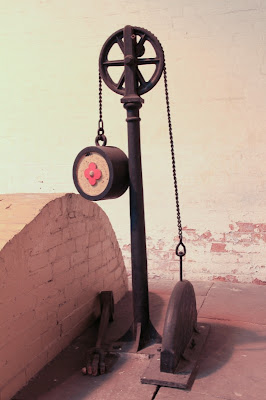This site is Britain's finest working Pumping Station at Papplewick, it is a Victorian Water Works which has been restored and preserved to a very high standard showing the excellent Craftsmanship from the Victorian era.
This site has many original features which include an ornate Engine House, an ornamental Cooling Pond and a Boiler House with 6 complete Lancashire Boilers all this is set against a beautiful landscaped grounds. The Engine House has its original twin beam Engines which was built by James Watt and Co in the year of 1884, this has special interest for its excellent and outstanding combination of Victorian engineering and artistic design.
If you visit here you will see elaborately decorated columns, stained glass windows and highly polished brass and mahogany wood and the engine herself in all her splendour.
Below are a few pictures taken before and during Steam running giving excellent representation of this beautiful Engine, also there are several short video clips showing different parts of these engines or at the end is a single video of all the small video clips in full.
Time to enter the Pumping Station.
There are two independent Steam Engines within this building,
One is for drawing water up out of the 200 foot deep well and
the Second is for pumping the water to the Reservoir.
The whole system is set on four floors.
The Ground Floor looking from the main doorway.
The Ground Floor looking from the main doorway.
Cast Iron Columns showing very nice Victorian Craftsmanship.
Governors for one of the Pumping Engines.
Linkage connectors at the bottom of the well Pump.
Control Levers for the Pumping Engine to pump water to the Reservoir.
Heading to the First floor.
First Floor with a view to the top of the First Piston
And more linkage going to the Second floor.



Time to head to the Second floor.
Second floor and a look at the Twin Beams
Some of the Top Linkage to one of the Beams.
Looking at the roof you can see the Eye Bolts set within the
wooden structure where the Victorians would more than likely
use a block and tackle for hoisting the beams when in need of
repair.

The Boiler House containing 6 Lancashire Boilers
2 are fully originals and the other four have had work
done on them in one way or another.

Time to fuel the fire.

Around the grounds.

A disused Electric Generator.

A set of small weighing scales for weighing Coal
going to the boiler.
A look within the Mechanics repair shop.
Several line shaft driven machinery and Steam powered machinery.
Plans of the building.

And more linkage going to the Second floor.



Time to head to the Second floor.
Second floor and a look at the Twin Beams
Some of the Top Linkage to one of the Beams.
Looking at the roof you can see the Eye Bolts set within the
wooden structure where the Victorians would more than likely
use a block and tackle for hoisting the beams when in need of
repair.

The Boiler House containing 6 Lancashire Boilers
2 are fully originals and the other four have had work
done on them in one way or another.

Time to fuel the fire.

Around the grounds.

A disused Electric Generator.

A set of small weighing scales for weighing Coal
going to the boiler.
A look within the Mechanics repair shop.
Several line shaft driven machinery and Steam powered machinery.
Plans of the building.

Within the grounds you can pay an extra £2 to get a tour of the Victorian Underground Reservoir and you get there by mini bus (included in the price).
There are some dodgy looking people on this bus but none
more than the Photographer !.


















































No comments:
Post a Comment